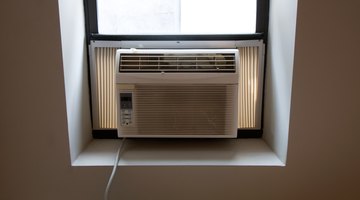Opportunities for careers in heating, ventilation and air conditioning -- known as HVAC -- are expected to grow faster than the average for other fields by 2020, according to the Bureau of Labor Statistics Occupational Outlook Handbook. To get started as an HVAC technician, students first need to get a degree, which can take up to two years to complete depending on the school and the program.
What an HVAC Technician Does
HVAC technicians can install, maintain, diagnose and repair air conditioning and heating units in both residential and commercial properties. Some technicians may also learn how to service refrigeration units and can get a heating, ventilation, air conditioning and refrigeration, or HVACR, degree or certification. Technicians can be self-employed, or they can work for a repair service or for a large company. The job carries a certain amount of risk since it requires working with electrical and mechanical components and includes exposure to potentially toxic chemicals. Technicians may also be required to work in tight spaces or high places.
HVAC Degree
An HVAC degree is typically completed at a trade school or community college, and it takes on average two years to complete. However, some schools offer accelerated programs that can be completed more quickly. Other schools offer a job-ready certification that can be completed in as little as 15 weeks. The degree program and the certification teach the basic knowledge required for the job, such as electrical work, understanding of HVAC system mechanics and how to take proper safety measures.
Apprenticeship and Licensure
Some states may require that HVAC technicians undergo a hands-on apprenticeship after they receive their education. The apprenticeship can last as long as 3 to 5 years, though it depends on the state. In some cases, the apprenticeship can be completed in place of a degree. Many states then require HVAC technicians to be licensed before they can begin working. Licensing requirements vary by state, but they include passage of a written test that measures knowledge of basic HVAC installation and repair, as well as electrical codes.
Employment Outlook
Those who graduate with an HVAC degree have a positive employment outlook. The Bureau of Labor Statistics estimates that job opportunities will grow by 34 percent by 2020, which is faster than average for other sectors. At least 90,300 jobs are expected to be created. The median pay for HVAC technicians in 2010 was $42,530 per year, or $20.45 per hour.
2016 Salary Information for Heating, Air Conditioning, and Refrigeration Mechanics and Installers
Heating, air conditioning, and refrigeration mechanics and installers earned a median annual salary of $45,910 in 2016, according to the U.S. Bureau of Labor Statistics. On the low end, heating, air conditioning, and refrigeration mechanics and installers earned a 25th percentile salary of $35,440, meaning 75 percent earned more than this amount. The 75th percentile salary is $58,960, meaning 25 percent earn more. In 2016, 332,900 people were employed in the U.S. as heating, air conditioning, and refrigeration mechanics and installers.
Related Articles
References
- Bureau of Labor Statistics Occupational Outlook Handbook: Heating, Air Conditioning, and Refrigeration Mechanics and Installers
- Front Range Community College: Heating & Air Conditioning (HVAC)
- U.S. Bureau of Labor Statistics: Occupational Outlook Handbook: Heating, Air Conditioning, and Refrigeration Mechanics and Installers
- Career Trend: Heating, Air Conditioning, and Refrigeration Mechanics and Installers
Writer Bio
Maria Magher has been working as a professional writer since 2001. She has worked as an ESL teacher, a freshman composition teacher and an education reporter, writing for regional newspapers and online publications. She has written about parenting for Pampers and other websites. She has a Master's degree in English and creative writing.











